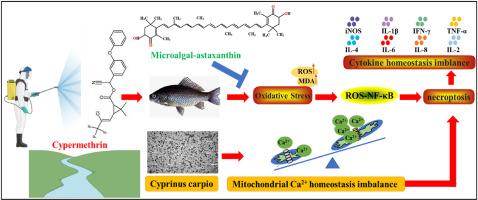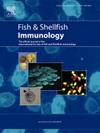Microalgal astaxanthin ameliorates cypermethrin-induced necroptosis and inflammation via targeting mitochondrial Ca2+ homeostasis and the ROS-NF-κB-RIPK3/MLKL axis in carp hepatocytes (Cyprinus carpio)
IF 4.1
2区 农林科学
Q1 FISHERIES
引用次数: 0
Abstract
Cypermethrin is a toxic pesticide that has infiltrated water bodies due to its widespread use. This contamination has led to detrimental effects on the immune organs of aquatic species, including fish. The natural fat-soluble orange-red carotenoid, astaxanthin (MAT), derived from microalgae, possesses anti-inflammatory, antioxidant, and immunomodulatory properties. To elucidate the mechanism of CY induced damage to carp liver cells and assess the potential protective effects of MAT, we established a carp hepatocyte model exposed to CY and/or MAT. Hepatocytes from carp (Cyprinus carpio) were treated with either 8 μM CY or 60 μM MAT for 24 h. Upon exposure CY, a significant increase in reactive oxygen species (ROS) was observed alongside a diminution in the activities of key antioxidant enzymes, superoxide dismutase (SOD) and catalase (CAT), suggesting an impairment of cellular antioxidant capacity. Subsequently, acridine orange/ethidium bromide (AO/EB) staining and flow cytometry analysis revealed that hepatocytes exposed to CY exhibited a higher incidence of necroptosis, associated with an elevated mitochondrial Ca2+ concentration, which contributed to cellular dysfunction. Furthermore, exposure to CY also activated the ROS-NF-κB-RIPK3/MLKL signaling pathway, increasing the levels of necroptosis-related regulatory factors (RIP1, RIP3, and MLKL) in hepatocytes and the expression of inflammatory genes (IL-6, IFN-γ, IL-4, IL-1β, and TNF-α), which led to immune dysfunction in hepatocytes. The immunotoxic effects induced by CY were mitigated by MAT treatment, suggesting its potential in alleviating the aforementioned changes caused by CY. Overall, the data suggested that MAT therapy could enhance hepatocyte defenses against CY-induced necroptosis and inflammatory responses by regulating mitochondrial Ca2+ homeostasis and inhibiting the ROS-NF-κB-RIPK3/MLKL signaling cascade. This study elucidated the potential benefits of employing MAT to protect farmed fish from agrobiological hazards during CY exposure, underscoring the practical applications of MAT in aquaculture.

微藻虾青素通过靶向线粒体 Ca2+ 平衡和鲤鱼肝细胞中的 ROS-NF-κB-RIPK3/MLKL 轴,改善氯氰菊酯诱导的坏死和炎症。
氯氰菊酯是一种有毒杀虫剂,由于广泛使用,已经渗入水体。这种污染对包括鱼类在内的水生物种的免疫器官造成了有害影响。从微藻中提取的天然脂溶性橙红色类胡萝卜素虾青素(MAT)具有抗炎、抗氧化和免疫调节的特性。为了阐明 CY 诱导鲤鱼肝细胞损伤的机制并评估 MAT 的潜在保护作用,我们建立了一个暴露于 CY 和/或 MAT 的鲤鱼肝细胞模型。鲤鱼肝细胞经 8 μM CY 或 60 μM MAT 处理 24 小时后,活性氧(ROS)显著增加,主要抗氧化酶、超氧化物歧化酶(SOD)和过氧化氢酶(CAT)的活性降低,表明细胞抗氧化能力受损。随后,吖啶橙/溴化乙锭(AO/EB)染色和流式细胞术分析表明,暴露于 CY 的肝细胞出现坏死的几率更高,这与线粒体 Ca2+ 浓度升高有关,从而导致细胞功能障碍。此外,暴露于 CY 还激活了 ROS-NF-κB-RIPK3/MLKL 信号通路,增加了肝细胞中坏死相关调节因子(RIP1、RIP3 和 MLKL)的水平和炎症基因(IL-6、IFN-γ、IL-4、IL-1β 和 TNF-α)的表达,从而导致肝细胞免疫功能紊乱。MAT 治疗减轻了 CY 引起的免疫毒性效应,这表明 MAT 有可能减轻 CY 引起的上述变化。总之,这些数据表明,MAT疗法可通过调节线粒体Ca2+平衡和抑制ROS-NF-κB-RIPK3/MLKL信号级联,增强肝细胞对CY诱导的坏死和炎症反应的防御能力。这项研究阐明了在 CY 暴露期间使用 MAT 保护养殖鱼类免受农业生物危害的潜在益处,强调了 MAT 在水产养殖中的实际应用。
本文章由计算机程序翻译,如有差异,请以英文原文为准。
求助全文
约1分钟内获得全文
求助全文
来源期刊

Fish & shellfish immunology
农林科学-海洋与淡水生物学
CiteScore
7.50
自引率
19.10%
发文量
750
审稿时长
68 days
期刊介绍:
Fish and Shellfish Immunology rapidly publishes high-quality, peer-refereed contributions in the expanding fields of fish and shellfish immunology. It presents studies on the basic mechanisms of both the specific and non-specific defense systems, the cells, tissues, and humoral factors involved, their dependence on environmental and intrinsic factors, response to pathogens, response to vaccination, and applied studies on the development of specific vaccines for use in the aquaculture industry.
 求助内容:
求助内容: 应助结果提醒方式:
应助结果提醒方式:


